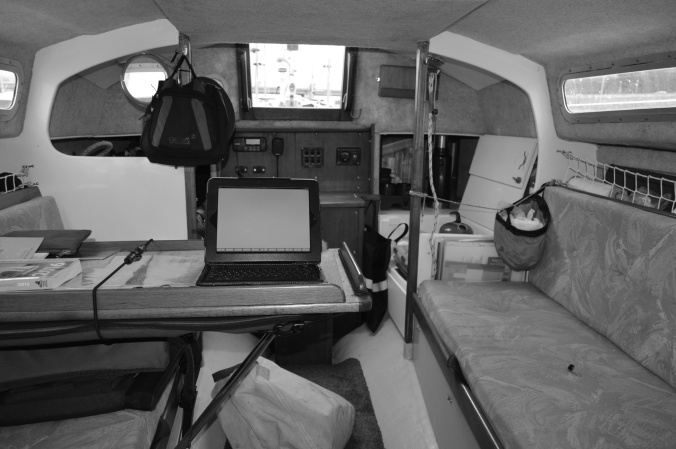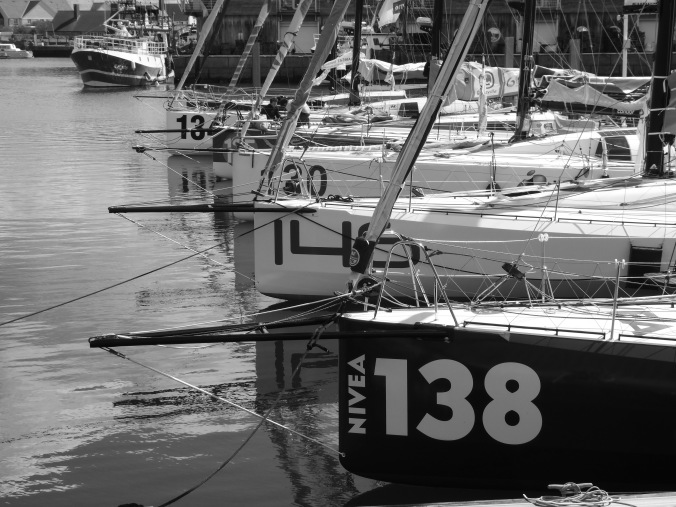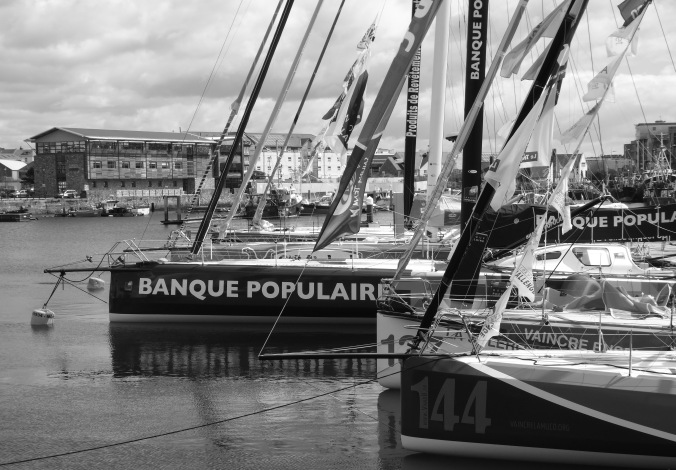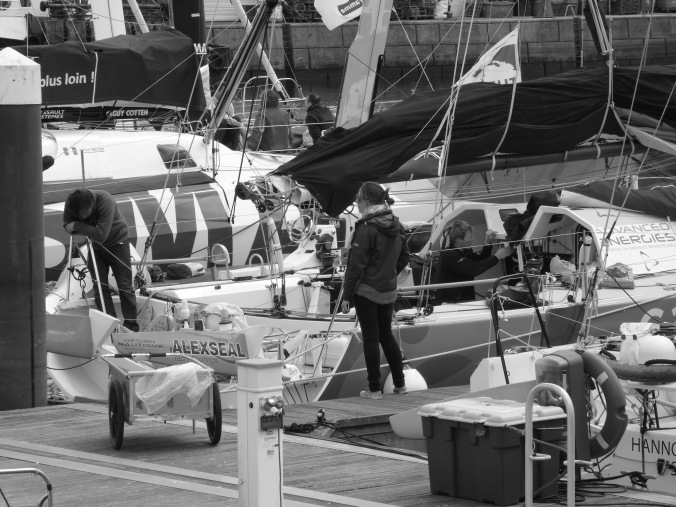

On the Morgan Giles slip in Teignmouth. Lines need tightening.

A swift ‘scrape off the barnacles and one coat of antifoul’ between tides.


On the Morgan Giles slip in Teignmouth. Lines need tightening.

A swift ‘scrape off the barnacles and one coat of antifoul’ between tides.
I have been reading ‘A Space to Write’, a series of illustrated interviews with Cornish writers by Amanda Harris, with photography by Steve Tanner and a forward by Michael Morpurgo, (published by KEAP, the Kernow Education Arts Project). Of course, it made me consider the room I am in now, with its books, souvenirs and references to Steeple Point, I thought it would be a good place to restart this blog. However, there is another place. If my space at home is a place where everything is gathered round, then the space on the boat is free for inspiration.
I am concerned that overstating the case may kill the process. How often I have become jammed by too much thought, too much research. The trick has been to get something into written form before ‘killing it with too much love’. So I don’t want to spoil my boat space by talking directly about why it inspires me. Maybe it will become obvious if I describe the space.
To give you a contrast, we recently chartered a yacht in the Southern Ionian. Three couples, three double cabins, a large saloon, and a galley with double sink, two burner hob, oven and a microwave. As far as accommodation was concerned, if this had been on land it would be called a chalet. There was plenty of space to share, the sailing was perfect. We had a great holiday, returned happy – all still speaking to one other.
The space on my boat is very different. For a start, there is no headroom. I am 5ft 8in, I have to bend to stand. There is a trick to putting on trousers and zipping them up, even more so to putting heavy weather gear on.
When I bought the boat, ten years ago, I spent the first six or seven years developing it the way I wanted to sail it – as a single-hander, (left-handed to boot!). There was no question of a ‘writing mode’ in those days. This has evolved.

Below deck, it was important for me to retain a sense on space. I used the quarter berths and lockers under the side berths for stowage, everything packed in named waterproof bags – easy to access. I have built a small bookcase that fits into the entrance of the port quarter berth. This is be secured with a lanyard and can be pulled forward when I want to get behind it. The fore cabin can be closed off with a white canvas ‘curtain’.
The galley stows beneath a hinge locker lid. I inherited a gimballed paraffin stove but removed it to make more space – first in favour of a JetBoil stove which I liked very much. Unfortunately, I irreparably damaged it one fateful day, dismantling it in a lumpy sea. I currently use a standard ‘picnic’ gas stove which works well, can be used instantly, the kettle boils quickly – (very important. I drink a lot of coffee and tea), and is small enough to have all the ingredients stowed with it (coffee, tea, dare I say “biscuits”) in the galley locker.

To create the impression of space, the bulkheads and exposed surfaces were painted white, the floor a light grey. Varnish was left where varnish does. Because there had been a lot of leakage through deck fittings over the years, the ceiling was in a terrible state and we lined it with fabric which both insulates and reduces condensation – cosy’s not the word but it’s comfortable!
A removable chart table was fitted crossways over the starboard berth. Charts are slung below the table. There is enough space between it and the port berth to move around. It can be dismantled and stowed forward when the starboard berth is in use.
Initially, when writing at the table, I sat askew. The cushions are relatively thick – I am told the material is used in the Princess yachts – (I can be sold almost anything). One day I was worrying about working with tools on deck and wondered whether I could run to some sort of separate worktop that could take scrapes and knocks. In my shed at home was an old shelf which might do, and could it do more?

Sanded, varnished, with pads either end (for stability and to protect various surfaces), and two eyes for lanyards when used on deck, I now have:
Facing aft, the view is out through the companion way, I can look port and starboard through the windows.
So, head just clearing the ceiling, iPad, paper and pencil, coffee to hand . . .
The view varying with wind and tide . . .
The music of a vessel on the water . . .
The old . . .

The new . . .

The very new . . .

Note the bystanders on the pontoon.
These vessels will sail for New York on Monday, 2nd May 2016 – no passengers.
(Images by Bill Whateley)
A quiet morning before the pre-start jazz . . .


Well, quiet forward, with time to please the sponsors . . . but not so quiet aft . . .

They leave Plymouth for New York on Monday
(Images by Bill Whateley)
How would you spend all day in a space about six feet across from back rest to back rest, and approximately ten foot long with no headroom to stand upright?
One of the features of a boat that was launched in 1988 is that any fittings that haven’t already been replaced are now over twenty five years old. I thought of this yesterday when, the winds having abated, we were able to get a couple of jobs done that had been scheduled for two days earlier.
I took the boat down river to Plymouth Yacht Haven. We slipped into a berth beside yachts twice the size of Blue Mistress. In such austere company we seem to be batting above our league. However, let’s concentrate on the job in hand . . .
Now the boat is back in the water, I can assess the changes made over the winter.
One of the tricks for a single-hander is to be able to lower the foresail and dowse it before the bulk of the sail slides under the lifelines and into the water. 99 times out of 100, there’s no problem. Occasionally everything goes wrong. It happened to me at the end of last year and it was time to do something about it.
In a recent post, Bill Serjeant has reminded us of his Folksong (Zeta), which he passed on to Julian Mustoe. The latter bought her for a specific voyage, totally rebuilding her coach roof and renaming her Harrier. It’s Bill’s story and I will let him tell it – (link below).
Blue Mistress is slowly coming together.
Because we won’t be back in the water before Easter, I have had time to tackle the planned jobs and some unplanned ones as well – like painting the floors of the quarter berths.
I now know why I avoided this for so long. It meant forcing my 42 inch chest five feet down two 38 inch holes – cleaning, sanding and then one, two, three coats – shoulders hunched, arms outstretched, pushing an open paint-pot before me, having to work out how to use my right hand accurately and then how to worm my way backwards without touching the fresh paint.
As we walked past I glanced up and thought, “That’s a fine-looking dinghy.”
And then, “That’s an interesting way of stowing it.”